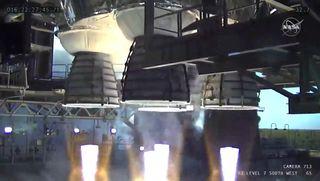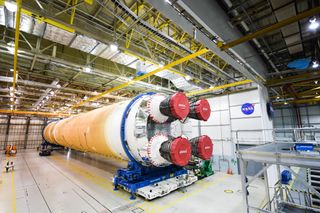Critical engine test for NASA's Space Launch System megarocket shuts down earlier than planned
This liquid fuel engine is a beast.
NASA fired up the core stage of its massive new rocket — the Space Launch System (SLS) — on Saturday (Jan. 16) in a critical test that ended prematurely when the booster's engines shut down earlier than planned.
Smoke and flames billowed from the four RS-25 engines that power the behemoth rocket's core booster, a centerpiece of NASA's Artemis moon program, as it roared to life atop a test stand at NASA's Stennis Space Center near Bay St. Louis, Mississippi. Ignition occurred at 5:27 EST (2227 GMT), with 700,000 gallons (2.6 million liters) of cryogenic fuel flowing through the engines as they roared for just over 1 minute, much shorter than planned.
The test was supposed to run for 485 seconds (or just over 8 minutes), which is the amount of time the engines will burn during flight. Following engine ignition, the four RS-25 engines fired for just over 60 seconds, NASA said.
"Not everything went according to script today," NASA chief Jim Bridenstine said late Saturday after the test. "But we got a lot of great data, a lot of great information."
Video: How NASA's SLS megarocket engine test works



An early engine shutdown
It's still too early to know exactly what caused the early shutdown in Saturday's engine test.
Flight controllers could be heard during the test referring to an "MCF" (a major component failure) apparently related to engine No. 4 on the SLS booster. John Honeycutt, NASA's SLS program manager, added that at about the 60-second mark, cameras caught a flash in a protective thermal blanket on the engine, though its cause and significance remain to be determined.
Sign up for the Live Science daily newsletter now
Get the world’s most fascinating discoveries delivered straight to your inbox.
Honeycutt said it's too early to know if a second hot-fire test will be required at Stennis, or if it can be done later at NASA's Kennedy Space Center in Florida, where the SLS is scheduled to launch the uncrewed Artemis 1 mission around the moon by the end of this year. Similarly, it's too early to know if Artemis 1 will still be able to launch this year.
"I think it's still too early to tell," Bridenstine said of whether a 2021 launch for Artemis 1 is still in the cards. "As we figure out what went wrong, we're going to know kind of what the future holds."

During a press conference on Tuesday (Jan. 12), John Shannon vice president and program manager for SLS at Boeing, said that the engines needed to run for a certain amount of time to get the data they needed. "If we had an early shutdown, for whatever reason, we get all of the engineering data we need to have high confidence in the vehicle at about 250 seconds," Shannon said.
Since the test was stopped short of 250 seconds, and before the teams were able to gimble (or move) the engines, exactly how much data and how confident the teams are in the vehicle is yet to be determined.
Saturday's test was initially moved up an hour to 4 p.m. EST (1900 GMT) as test preparations were ahead of schedule. However, during the countdown, engineers put the count on hold to work through water deflection system checks and other tests on the engine test stand. The teams were able to work through the issues and resume the count in time to complete the test Saturday, despite the short run time.
The exercise, known as a hot-fire test, put the core Space Launch System booster components — the four RS-25 main engines, fuel tanks and the rockets computers and avionics — through their paces. The test simulated a launch while holding the rocket firmly in place, affixed to a test stand. (The same test stand was used to test out the engines on both NASA's Saturn V rocket and space shuttle orbiters.)
"The SLS rocket is the most powerful rocket ever built in the history of humanity," Bridenstine said on NASA TV shortly before the test. "This is the same rocket that, by the end of this year, will be launching an Orion crew capsule around the moon."
Anatomy of the Space Launch System
NASA's Space Launch System was first conceived in 2011 and is finally coming together for an uncrewed trip around the moon sometime later this year.
Each SLS rocket will use four RS-25 rocket engines to launch its 212-foot (65-meter) core stage. The rocket will also rely on two solid rocket boosters and an upper stage to launch NASA's Orion crew capsule beyond low-Earth orbit.
Together, SLS and Orion are the two major components of NASA's Artemis moon program which seeks to return astronauts to the moon as soon as 2024.
The agency currently has 16 RS-25 engines on hand, which were salvaged from the agency's now-retired space shuttle program. Those engines will be used on the first four SLS rocket launches for Artemis missions 1 through 4. (Those flights include the program's first crewed moon landing, Artemis 3, and a follow-up flight.)
Space Launch System: NASA's giant rocket for Artemis moon missions explained
Since the engines on those first missions are shuttle leftovers, they've been overhauled with new computer controllers as well as upgrades that ensure they can handle the higher performance demands of an SLS launch, NASA officials have said.
That's not the only part recycled from programs past. Like the engines, the solid rocket boosters were also used to propel NASA's fleet of space shuttles to orbit. They too, have been modified to work with SLS. But they won't be used forever. As technology evolves, the side boosters will be swapped out for advanced boosters.
The SLS will contain a pair of these boosters strapped onto the side of the core stage. It consists of four RS-25 engines at the base of the vehicle, and stacked on top will be the rocket’s components with an Orion capsule and service module perched atop.
The whole vehicle will be capped off with a launch orbit system that is designed to pull the capsule away from the rocket if something goes wrong during a launch.
Road to the test pad
NASA has been systematically testing the various components of the SLS rocket over the past few years.
The agency tested each of the main engines separately to ensure they fired up as expected. And to ensure the flight hardware meets design expectations, NASA began what it calls a "Green Run" test which included testing the craft's avionics, countdown and launch timeline, fueling procedures and more.
The testing went smoothly but not without issues. A global pandemic coupled with an unprecedented number of tropical storms and hurricane impacting the test sites added to delays caused by hardware issues.
NASA conducted two separate "wet dress rehearsals," in which fuel was loaded into the engines and then subsequently drained. During one such exercise, which took place on Dec. 20, the test ended early unexpectedly, causing today's hot-fire test to be delayed from December, according to a NASA statement. Another fueling attempt earlier in December was stalled due to temperature issues.
The runup to Saturday's engine tests also saw a series of delays due to the ongoing coronavirus pandemic, NASA officials said. Social distancing restrictions meant that many of the NASA officials, engineers and other SLS team members (as well as the media) could not be on hand in person to witness the pivotal rocket test. Many team members sent in videos to participate virtually.
Testing is key

The purpose of the test is to ensure that the rocket will be able to carry an uncrewed Orion spacecraft on a journey around the moon later this year.
With the ignition of the four RS-25 engines, it closed out a critical period of preflight testing for the rocket that NASA referred to as its "Green Run." That series of tests began with stress tests on the physical structure of the rocket and ended with today’s hot fire test.
The goal of the test was to run through launch day procedures, and ignite the four engines, allowing them to burn for just over 8 minutes — just shy of the duration they will burn during an actual flight. That full-duration test fire clearly did not happen.
It will take the teams at least several days to review the SLS test data before deciding on next steps, such as the requirement for more tests or clearing the core stage for its next step: refurbishment and eventual transportation to the launch site at Kennedy Space Center in Florida.
Once it does arrive in Florida, it will be integrated with the rest of the vehicle that is already onsite. This includes its two solid rocket boosters, which are currently being stacked in the Vehicle Assembly Building at Kennedy Space Center.
The boosters were previously tested before being shipped in segments to Florida. Each booster consists of five segments that are stacked on top of one another.
The Orion spacecraft is complete and nearly ready to be affixed to the top of the SLS once the rocket is fully assembled.
Bridenstine stressed late Saturday that despite the early engine shutdown, the SLS hot fire shouldn't be regarded as a failure, but as a test the agency will surely learn from.
"I have absolutely total confidence in the team to figure out what the anomaly was, figure out how to fix it and then get after it again," he said. "Because we don't fail. We might have a setback, and then we come back and we do it again."
Editor's note: This story, originally posted at 6:53 p.m. EST, was updated at 9:39 p.m. EST with more details from NASA's post-test press conference.
Follow Amy Thompson on Twitter @astrogingersnap. Follow us on Twitter @Spacedotcom or Facebook.
Most Popular

